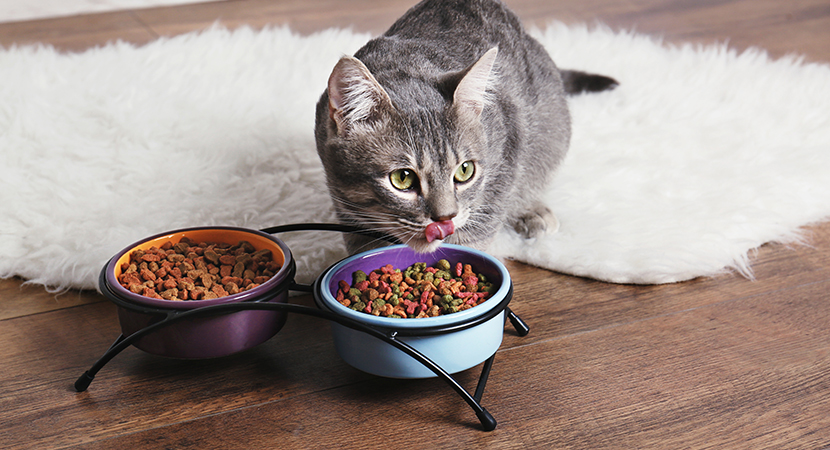
Palatability of food in cats
Several important factors play a role in the food choice of cats. In particular, the palatability and nutritional composition of the food, as well as the cat's previous experience. The concept of palatability encompasses various sensory properties of the food, such as its smell, taste and texture. The cat uses the sense of smell as its first sense when eating food. Based on the smell, it decides whether or not to accept it. If for some reason it is unable to detect food by smell, it will usually refuse to accept it. The smell of the food can be enhanced, for example, by heating the food, adding meat broth, tuna juice or other aromatic ingredients. The taste of the food is perceived by cats by means of taste buds located on the edges and root of the tongue and in the soft palate. Their number is considerably smaller than in humans. The cat can distinguish the taste of proteins and fats very well. It prefers the taste of animal fat, protein hydrolysates, meat extracts and free amino acids, which are a common component of muscle tissue. Based on the chemical composition, the cat can distinguish whether the prey is fresh or whether decomposition processes have already begun. It also has the ability to detect rancid or burnt fats. Certain taste bud receptors are able to detect substances that accumulate in mammalian tissues after death. Unlike dogs, cats have a natural aversion to carcasses and prefer fresh food. Other receptors are stimulated by sulphur-containing amino acids, including taurine, which is related to the need for this essential amino acid for cats. Carbohydrate sensitivity, on the other hand, is low, they cannot distinguish between different types of carbohydrates and they are not palatable to them. Their perception of sweet taste is very limited. Cats usually reject the taste of substances derived from plant products, such as medium-chain triglycerides. Unlike canids, feral cats also avoid consuming plant material contained in the digestive tract of their prey. However, domestic cats may occasionally show a preference for certain fruits and vegetables such as melon, pumpkin, bananas or celery. They are more sensitive than other species to bitter and sour tastes, which they reject. They also discriminate between salty taste, probably due to the high sodium content of their natural diet, and umami taste, the taste of glutamic acid and its salts. Cats are also very sensitive to the texture and temperature of their food. Their preference for a certain texture of food is mainly due to the experience they have gained in their youth. If they get used to a certain type and texture of food, they may reject other types later in life. Unless they are used to different textured foods from a young age, cats usually prefer solid, moist foods and do not like to accept foods with a powdery, sticky or too oily texture. This should be taken into account when introducing a new food. Cats are generally known to be conservative and distrustful of new foods with which they have no previous experience. They often prefer foods they have encountered in the first six months of their lives. They can easily develop neophobia, i.e. fear of a new, unfamiliar food, or they may develop a negative association between the intake of a particular food and an unpleasant experience (nausea, vomiting, stress). This can lead to the development of anorexia (food refusal), which is particularly dangerous in cats. A cat that does not accept food for more than three days should always be considered for some form of food support, as it is at risk of developing lipidosis (fatty liver). Food intake is not a social issue for cats, preferring to take it independently and in a quiet place. Ideally, the food should be around 38 °C, which is the temperature of freshly caught prey. Shallow and wider bowls are preferable to narrow and deep bowls for feeding cats so that their whiskers do not touch the sides of the bowl. As a hunter of small prey, the cat prefers to receive multiple small portions per day. In the wild, it must hunt 10 to 15 mice per day to meet its energy needs. Healthy cats usually naturally regulate their food intake so that they do not gain weight and can therefore have food freely available throughout the day. However, some cats have a tendency to overeat and these cats need to have their food intake restricted to prevent the development of obesity. Food intake may also be affected by ambient temperature or stress. In high outdoor temperatures, cats naturally take in less food than in colder periods. Absence of the owner, being in an unfamiliar environment, the arrival of a new pet and other stress factors can also affect appetite. Cats are generally more sensitive to these factors than dogs. If a cat has free access to food, it usually takes 7-16 small portions during the day and night. Many owners feed their cats 2 to 3 times a day, a regimen to which the cat can easily adapt. They usually do not eat the entire portion at once, but in batches, increasing the number of servings per day and thus mimicking the behaviour of feral cats. However, some cats will readily take larger portions of food at a time and will often beg their owner for more food. This type of behaviour can lead to excessive energy consumption and the development of obesity, so it is important to limit the amount of food offered in these situations. Cats usually consume moist food faster in the beginning, but the rate decreases later. Dry food is usually consumed more slowly and the rate of intake tends to be more constant.
MVDr. Eva Štercová, Ph.D.